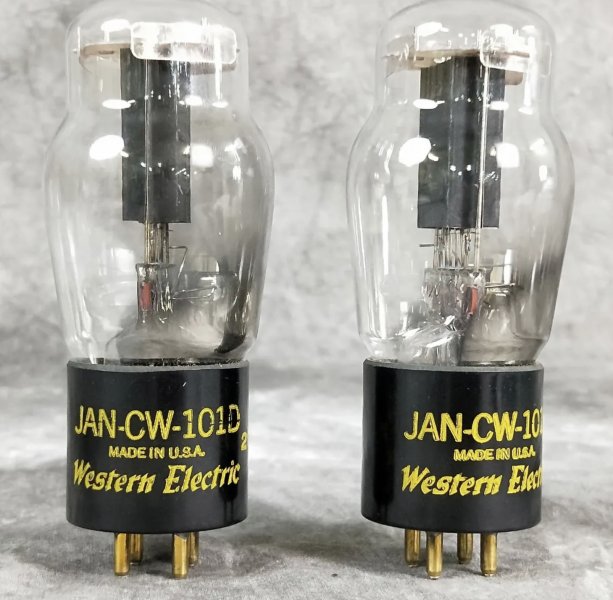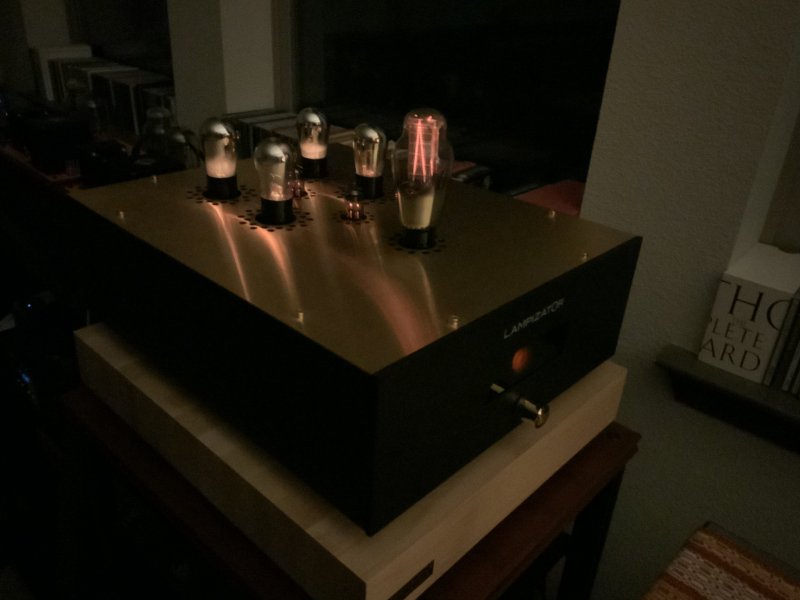Lampizator Valve / Tube Rolling Review Thread
- Thread starter Zero000
- Start date
You are using an out of date browser. It may not display this or other websites correctly.
You should upgrade or use an alternative browser.
You should upgrade or use an alternative browser.
Could you please provide the name of the preamp you found to be copacetic with the 242 in your Pacific? Thanks in advanceI may have a gently used pair to sell soon, once my new Horizon settles in and I can happily send the Pacific back to Lampi with its original tubes... They are the clear best in my Pac, once I found a preamp that could handle them.
I use an ARC Ref tube preamp, which works very nicely with the KR 242 tubes in my Pacific. ARC Ref preamps (except for the ancient Ref 1) have generous overload margins. This is a spec not often explicitly stated in solid state or tube preamps. It’s the most useful of specs. You ideally want overload margins to be around 20V. Lot of solid state preamps will clip if you feed them anything above 4V. These are to be avoided with KR 242 tubes. Alternatively if the preamp allows you to adjust the gain individually for each input, as for example Mark Levinson or McIntosh preamps do, that can work as well. I recall my ML 32 had three gain settings (0 dB, 6dB and 12 or 18 dB). The 0dB setting could accept up to 18V input without clipping.
The 242's worked like a charm with my current CH Precision L10 - - magical!Could you please provide the name of the preamp you found to be copacetic with the 242 in your Pacific? Thanks in advance
I got overload distortion when I tried them on my previous ARC Ref 40. Maybe that initial Ref model didn't have the overload margins, either. I also tried them with my D'Agostino Momentum HD and had a similar distortion problem.
Surprised to hear the Ref 40 overloaded. It has a high overload margin — 20V. I seriously doubt the Pacific was putting out that high a volume using KR 242 tubes. Did you have your Pacific on high gain?The 242's worked like a charm with my current CH Precision L10 - - magical!
I got overload distortion when I tried them on my previous ARC Ref 40. Maybe that initial Ref model didn't have the overload margins, either. I also tried them with my D'Agostino Momentum HD and had a similar distortion problem.
I'm not sure. My Pacific did not come with switchable gain.Surprised to hear the Ref 40 overloaded. It has a high overload margin — 20V. I seriously doubt the Pacific was putting out that high a volume using KR 242 tubes. Did you have your Pacific on high gain?
I'm not sure. My Pacific did not come with switchable gain.
same with golden gate and 242, never worked with AR models. Between GG and PAC have heard 242 Worked with analog domain, Aries cerat, audionet stern, TAD, Alieno. There is a thread listing other preamps. I will try it with Thomas Mayer 10y later this year.
there is thread here with valves used and downstream electronics list that includes CH and Soulution and Lamm other preamps with 242.
Thread 'Lampi GG/Pac owners, downstream electronics list'
https://www.whatsbestforum.com/threads/lampi-gg-pac-owners-downstream-electronics-list.34334/
Not a good match. Neither technically nor in terms of circuit and sound philosophy IMO.I will try it with Thomas Mayer 10y later this year.
Not a good match. Neither technically nor in terms of circuit and sound philosophy IMO.
Regarding the amp, we were trying to check what kind of drive the speaker requires. It requires a bit of push pullness and oomph. It was not a compare of sonics of amps, but more to test the requirement of the speaker.
Your comment on neither technically nor in terms of circuit...can you please clarify?
Hi!Regarding the amp, we were trying to check what kind of drive the speaker requires. It requires a bit of push pullness and oomph. It was not a compare of sonics of amps, but more to test the requirement of the speaker.
Your comment on neither technically nor in terms of circuit...can you please clarify?
If the speaker needs more drive you need to check the power amp not swap preamps that does not make sense.
The DAC uses DHTs in cathode follower mode and I assume capacitor coupled outputs unless it uses some DC servo scheme. I am not implying that such a circuit is bad, it is a matter of choice. My preamp uses a very different choice which is sonically very different. No feedback no cathode followers, no coupling caps. These are opposite philosophies.
Also that DAC has a very high output level. Wie the 10Y is very overload proof it is designed to work best with typical line level values. If customers insist on using sources with such high output levels I employ step down input transformers to reduce that level to more practical values.
best regards
Thomas
Hi!
If the speaker needs more drive you need to check the power amp not swap preamps that does not make sense.
The DAC uses DHTs in cathode follower mode and I assume capacitor coupled outputs unless it uses some DC servo scheme. I am not implying that such a circuit is bad, it is a matter of choice. My preamp uses a very different choice which is sonically very different. No feedback no cathode followers, no coupling caps. These are opposite philosophies.
Also that DAC has a very high output level. Wie the 10Y is very overload proof it is designed to work best with typical line level values. If customers insist on using sources with such high output levels I employ step down input transformers to reduce that level to more practical values.
best regards
Thomas
Sorry, misunderstanding. We used the amp swaps to check for drive.
We did not use the dac for input, we used the PTP Lenco with Audionote field coil cartridge via your D3a phono into your 10y preamp. This is mentioned in my pictures post below the first picture. The AN fieldcoil has a music first SUT
Then, we swapped out the D3a and 10y to the Shindo Monbrison which is a built in phono with preamp
ok sorry, did not read the whole thread just your post where it mentions the DAC and 10y. my bad
Actually confusion seems to be on my side
I now see you are on the Lampi thread, where I was speculating going to the place with my Lampi for the preamp compare. That guy also had another Lampi, which we did not try, hence the confusion.
I now will take note of your feedback that cathode followers plus cap coupled outputs might not work well with your designs.
Ok !
It will work of course but in my opinion will not give the best possible SQ as if you are combing gear which follows similar philosophies
Thomas
It will work of course but in my opinion will not give the best possible SQ as if you are combing gear which follows similar philosophies
Thomas
I'm not sure. My Pacific did not come with switchable gain.
You are saying that your Pacific does not have 2 switches underneath the top cover which can cut the output by x dB (I forget the amount)?
Has to have it I would sayYou are saying that your Pacific does not have 2 switches underneath the top cover which can cut the output by x dB (I forget the amount)?
How's it going buddy?Worked very normally with my Ref6 and absolute no issue with Tobian preamps...
Increasingly, DACs are produced that generate fairly high levels. My solid state Chord Dave produces quite a high voltage output in DAC mode — I think it might be 6V. One reason is that many DACs are used in lieu of preamps and manufacturers want to provide plenty of drive for a variety of amplifiers. I think the safest option is to get a preamp with gain matching or one with high overload margins.Hi!
If the speaker needs more drive you need to check the power amp not swap preamps that does not make sense.
The DAC uses DHTs in cathode follower mode and I assume capacitor coupled outputs unless it uses some DC servo scheme. I am not implying that such a circuit is bad, it is a matter of choice. My preamp uses a very different choice which is sonically very different. No feedback no cathode followers, no coupling caps. These are opposite philosophies.
Also that DAC has a very high output level. Wie the 10Y is very overload proof it is designed to work best with typical line level values. If customers insist on using sources with such high output levels I employ step down input transformers to reduce that level to more practical values.
best regards
Thomas
Similar threads
- Replies
- 6
- Views
- 919
- Replies
- 16
- Views
- 2K
- Replies
- 10
- Views
- 2K
- Replies
- 10
- Views
- 2K
| Steve Williams Site Founder | Site Owner | Administrator | Ron Resnick Site Owner | Administrator | Julian (The Fixer) Website Build | Marketing Managersing |












